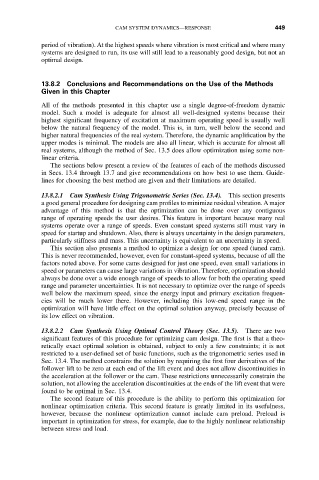Page 461 - Cam Design Handbook
P. 461
THB13 9/19/03 7:56 PM Page 449
CAM SYSTEM DYNAMICS—RESPONSE 449
period of vibration). At the highest speeds where vibration is most critical and where many
systems are designed to run, its use will still lead to a reasonably good design, but not an
optimal design.
13.8.2 Conclusions and Recommendations on the Use of the Methods
Given in this Chapter
All of the methods presented in this chapter use a single degree-of-freedom dynamic
model. Such a model is adequate for almost all well-designed systems because their
highest significant frequency of excitation at maximum operating speed is usually well
below the natural frequency of the model. This is, in turn, well below the second and
higher natural frequencies of the real system. Therefore, the dynamic amplification by the
upper modes is minimal. The models are also all linear, which is accurate for almost all
real systems, although the method of Sec. 13.5 does allow optimization using some non-
linear criteria.
The sections below present a review of the features of each of the methods discussed
in Secs. 13.4 through 13.7 and give recommendations on how best to use them. Guide-
lines for choosing the best method are given and their limitations are detailed.
13.8.2.1 Cam Synthesis Using Trigonometric Series (Sec. 13.4). This section presents
a good general procedure for designing cam profiles to minimize residual vibration. A major
advantage of this method is that the optimization can be done over any contiguous
range of operating speeds the user desires. This feature is important because many real
systems operate over a range of speeds. Even constant speed systems still must vary in
speed for startup and shutdown. Also, there is always uncertainty in the design parameters,
particularly stiffness and mass. This uncertainty is equivalent to an uncertainty in speed.
This section also presents a method to optimize a design for one speed (tuned cam).
This is never recommended, however, even for constant-speed systems, because of all the
factors noted above. For some cams designed for just one speed, even small variations in
speed or parameters can cause large variations in vibration. Therefore, optimization should
always be done over a wide enough range of speeds to allow for both the operating speed
range and parameter uncertainties. It is not necessary to optimize over the range of speeds
well below the maximum speed, since the energy input and primary excitation frequen-
cies will be much lower there. However, including this low-end speed range in the
optimization will have little effect on the optimal solution anyway, precisely because of
its low effect on vibration.
13.8.2.2 Cam Synthesis Using Optimal Control Theory (Sec. 13.5). There are two
significant features of this procedure for optimizing cam design. The first is that a theo-
retically exact optimal solution is obtained, subject to only a few constraints; it is not
restricted to a user-defined set of basic functions, such as the trigonometric series used in
Sec. 13.4. The method constrains the solution by requiring the first four derivatives of the
follower lift to be zero at each end of the lift event and does not allow discontinuities in
the acceleration at the follower or the cam. These restrictions unnecessarily constrain the
solution, not allowing the acceleration discontinuities at the ends of the lift event that were
found to be optimal in Sec. 13.4.
The second feature of this procedure is the ability to perform this optimization for
nonlinear optimization criteria. This second feature is greatly limited in its usefulness,
however, because the nonlinear optimization cannot include cam preload. Preload is
important in optimization for stress, for example, due to the highly nonlinear relationship
between stress and load.

